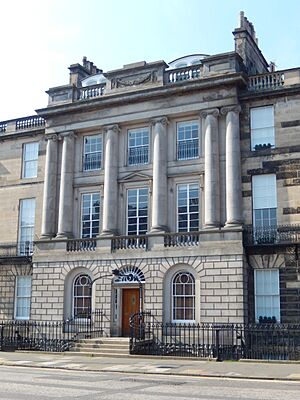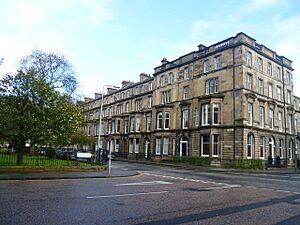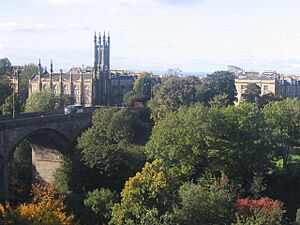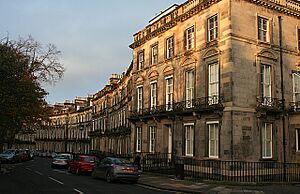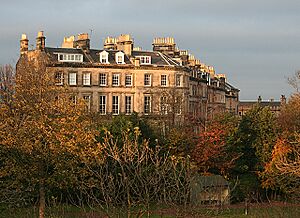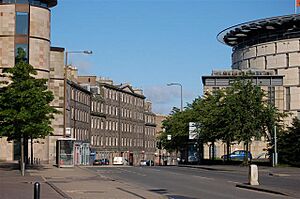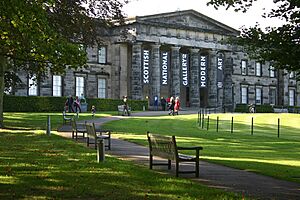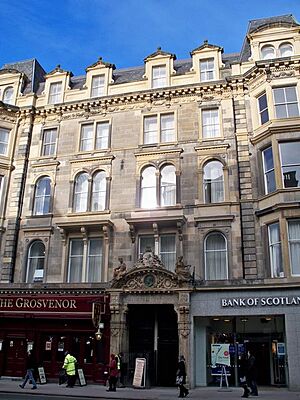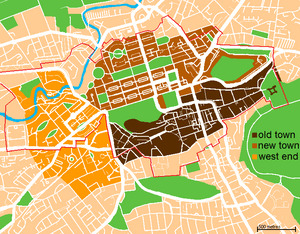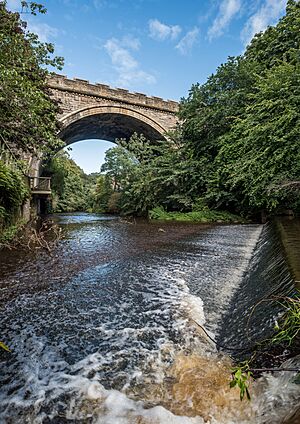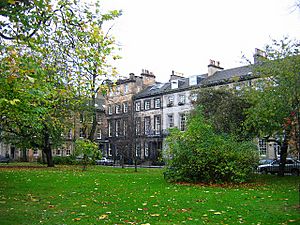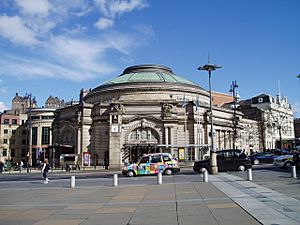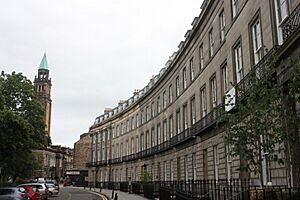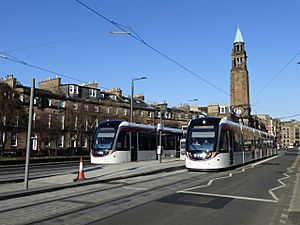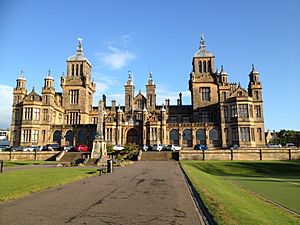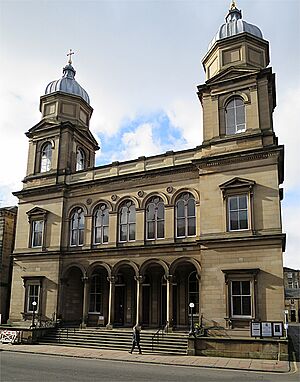West End, Edinburgh facts for kids
Quick facts for kids West End |
|
|---|---|
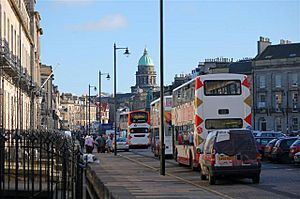 Melville Street looking down towards West Register House |
|
| Council area |
|
| Country | Scotland |
| Sovereign state | United Kingdom |
| Postcode district | EH2, EH3 |
| Dialling code | 0131 |
| Ambulance | Scottish |
| EU Parliament | Scotland |
The West End is a cool and fancy part of Edinburgh, Scotland. It's right in the middle of the city, joining up with the New Town and Old Town. Together, these areas are so special that they are a UNESCO World Heritage Site. This means they are protected because of their amazing history and buildings.
The West End is full of interesting places. You'll find lots of hotels, restaurants, and unique shops here. It also has offices and fun arts places. Some famous spots include the Edinburgh Filmhouse, where you can watch movies, and the Edinburgh International Conference Centre. The fancy Caledonian Hotel is also in this area. The West End often hosts art festivals and craft fairs, making it a lively place to visit.
This area was built as an expansion of the New Town. The northern part of the West End is next to the Water of Leith river. It's known for its beautiful Georgian houses. These are long rows of terraced homes built a long time ago. Many of the lovely New Town Gardens are also part of the West End.
The West End is one of Edinburgh's richest areas. Some of the most expensive streets in Scotland's capital are here. Many countries have their consulates (like mini-embassies) in the West End. Important church offices are also located here.
The West End is just west of the New Town and Old Town. It's surrounded by other districts like Stockbridge and Dean Village to the north. To the south are Tollcross and Fountainbridge. To the west, you'll find West Coates, Haymarket, and Murrayfield.
Contents
Exploring the West End's Past
Long ago, in 1615, a man named John Byres built a house called Easter Coates House. It was west of the city and had a huge estate. This house was like a big country home for a rich landowner. As Edinburgh grew, it became a city mansion for a wealthy citizen. This old house is still standing today and is a key part of the West End.
How the West End Began
The West End started to grow in the early 1800s. People wanted to expand Edinburgh's New Town to the west. In 1806, Shandwick Place was built as an extension of Princes Street. Later, Maitland Street was added.
Around 1800, William Walker bought the Easter Coates House estate. He was a lawyer and wanted to develop the land. In 1808, architect Robert Brown created a plan for the "West End Village." Rich people liked this area because the wind blew pollution away from it.
The plan made Melville Street the main road of the new Georgian West End. Other streets like Walker Street and William Street were built in a grid pattern. Construction started in 1813. Melville Street was mostly finished by the 1830s. In the middle of Melville Street, there's a bronze statue of Robert Dundas, a famous person from that time.
Another architect, James Gillespie Graham, designed parts of the area too. He built Alva Street, which is a great example of Georgian architecture. He also designed Queensferry Street, which connects the New Town to the West End.
The Victorian Era Expansion
Much of the West End stayed undeveloped until the 1860s. William Walker's family owned a lot of land here. His daughters, Mary and Barbara Walker, were very religious. They gave the land from their garden to build a big church. They also paid for the whole cost of building it.
This church was for the Scottish Episcopal Church. It was the first Anglican/Episcopal Cathedral in Edinburgh since 1690. Work on the cathedral began in 1873 and it opened in 1879. It was named St Mary's Episcopal Cathedral. The two front spires were added much later, in 1917.
The St Mary's Music School opened in 1880 to train singers for the cathedral. Later buildings in the West End, built after the mid-1800s, are called the "Victorian Extension." This includes Drumsheugh Gardens, built around a private garden in the 1870s.
More Victorian homes were built as the Walker family sold off land. These often had private gardens in the middle, just like the New Town Gardens. Palmerston Place connects the older Georgian West End with the newer Victorian parts.
In 1881, a tall bell tower was added to St George's West Church on Shandwick Place. This tower was designed by Sir Robert Rowand Anderson, a famous Scottish architect. He based it on a church in Venice, Italy.
The North West End
One part of the Victorian area curves north over the Dean Bridge. This bridge was built around 1838 by John Learmonth and engineer Thomas Telford. It helped open up land in the north of the West End.
Learmonth developed Clarendon Crescent, a beautiful row of homes. Plans for more streets, Oxford Terrace and Cambridge Terrace, were made. However, there was a disagreement about building on a steep slope. This slope later became the lovely Dean Gardens.
Due to delays, the rest of this land was developed much later. Sir James Steel, a wealthy builder, bought the land. He oversaw the building of Learmonth Terrace. At the end of Learmonth Terrace is Learmonth House, built in 1891 for a famous whisky maker. It later became the headquarters for a Royal Air Force squadron.
The South West End
The South West End is south of Shandwick Place, near Edinburgh Castle. This area was once known as the King's Garden. Over time, different landowners developed it.
Most of the South West End was built later than the northern part. Plans for canals and railways made development slow. By the 1820s, only a few projects had started, like on Morrison Street.
A beautiful church was built in 1831. The Edinburgh Princes Street railway station was built in the 1890s, with a grand hotel. The station closed in 1965, but the hotel is still there.
Edinburgh's first power station was built in the South West End in the 1890s. It used coal from nearby railway yards. Even though the power station is gone, the area is still a main electricity spot.
By the late 1800s, the South West End became known for the arts. The Royal Lyceum Theatre was built in 1883. The Usher Hall, a concert venue, opened in 1914. The Caley Picture House opened in 1923 as a cinema. Even though it's now a pub, the West End still has a strong connection to movies with the Edinburgh Filmhouse.
Shandwick Place was redeveloped in the late 1800s. It became famous for its art galleries and connection to Scottish artists. In the early 1900s, it was a busy shopping street with high-end car showrooms.
What's New in the West End
The West End was first built for homes. But since the mid-1900s, many buildings became offices. Shops are mostly on Shandwick Place, West Maitland Street, William Street, and Queensferry Street. William Street is special because it still has many 19th-century shopfronts.
The West End has been linked to the arts since the late 1800s. The Albert Gallery, built in 1876, was meant to promote fine art. Today, it's used as offices.
In 1984, the Scottish National Gallery of Modern Art opened. It has two galleries, Modern One and Modern Two. These galleries show amazing modern art.
In 1998, the Church of Scotland bought a house in the West End. It became the official home for the leader of their church. From 1999 to 2020, a building on Melville Crescent was the Edinburgh home for the Secretary of State for Scotland.
Around 2019, the City of Edinburgh Council started asking people for ideas to improve Randolph Place. They wanted to make it a nicer entrance to the West End Village. Ideas included adding green spaces and public art.
In the South West End, a group of buildings called The Exchange opened in the mid-1980s. It includes the Edinburgh International Conference Centre, a hotel, and offices for financial companies.
A new public square was created in 1984 near the Usher Hall. It was meant to be a big public space for Edinburgh's festivals. There are plans to make the road nearby more pedestrian-friendly. In 2021, plans were made for a new tower with cinema space in Festival Square.
West End's Location and Features
The West End is on the western side of central Edinburgh. It's next to the Old Town and the New Town. The Dean Village is surrounded by the West End on three sides.
Other nearby districts include Stockbridge to the northeast and Ravelston to the northwest. To the west are Haymarket, Murrayfield, and West Coates. To the south, you'll find Fountainbridge and Tollcross.
The northern part of the West End, with its Georgian buildings, is part of Edinburgh's World Heritage Site.
The Water of Leith river flows through the West End. The Belford Bridge is a main crossing into the area. The Dean Bridge helps traffic cross from the south to the north of the West End.
Shandwick Place, Princes Street, Queensferry Road, and Lothian Road all meet at Rutland Place. This creates an important junction in Edinburgh. Famous buildings like the Johnnie Walker building and The Caledonian Hotel are around this area.
How the West End is Governed
The West End has its own local group called the West End Community Council. This group helps represent the local community.
For local elections, the south of the West End is in the City Centre ward. The north part is in the Inverleith ward. These wards elect people to the City of Edinburgh Council.
For Scottish Parliament elections, the West End is part of the Edinburgh Central area. For UK Parliament elections, most of the West End is in the Edinburgh North and Leith constituency.
What Happens in the West End
The West End is a busy place with lots of offices, shops, restaurants, and cultural spots.
It's known for its arts scene. The Edinburgh Filmhouse hosts the Edinburgh International Film Festival, which is the oldest film festival in the world that's still running! The Scottish Arts Club, founded in 1873, is also here. The West End is a key location for the Edinburgh Festival Fringe, a huge arts festival. It also hosts the West End Fair, a big arts and crafts event. The Scottish National Gallery of Modern Art has two galleries in the West End.
Tourists love the West End. It has many hotels and hostels. William Street is a popular shopping spot, known for its unique fashion boutiques. It's even used by film crews for movie locations!
You'll find many places to eat and drink in the West End. There are also several consulates here. These are offices where countries like Germany, Switzerland, Turkey, India, and Italy handle their business in Scotland.
The Edinburgh International Conference Centre is in the South West End. This area is a big business district. Large companies like Standard Life have their headquarters here. The Exchange Tower is Edinburgh's tallest building. This part of the West End also has news and film companies.
Fun and Community in the West End
The West End is a hub for arts and culture. It's a key location during the Edinburgh Fringe Festival. The area is also known for being welcoming to the LGBTQ community.
Museums and Libraries
The Museum of the Incorporated Trades of Edinburgh is on Melville Street. This museum shows the history of Edinburgh's ancient craftsmen. It has old tools and artifacts.
The Library of Mistakes is also on Melville Street Lane. It's a special library for learning about financial history. It helps people learn from past money mistakes.
Art Galleries
The Scottish National Gallery of Modern Art is on the edge of the West End. It has two buildings, Modern One and Modern Two. You can reach them by walking over a bridge on the Water of Leith. There are also many smaller art galleries in the area.
Movies and Shows
The Edinburgh Filmhouse is in the West End. It hosts the Edinburgh Film Festival. The Usher Hall (for concerts), Traverse Theatre, and Royal Lyceum Theatre (for plays) are near the South West End. The Edinburgh International Conference Centre is also here.
Parks and Green Spaces
The West End has several parks and gardens. Many of these are private, like the Dean Gardens and Drumsheugh Gardens. Rutland Square is another private garden square.
Atholl Crescent Gardens are public gardens. They have a large statue of William Ewart Gladstone, a famous British Prime Minister.
Near the Water of Leith, there's the AIDS Memorial Park. It's a special place to remember those affected by HIV/AIDS.
Buildings and Design
The West End is famous for its beautiful buildings. The Georgian architecture of the New Town and West End is the largest area of its kind in Europe. This is why it's a UNESCO World Heritage Site. People call it "the Scottish Enlightenment in stone" or "the Athens of the North."
The old Easter Coates House and the gothic St Mary's Cathedral offer a different look. The West End has a heritage trail with signs that tell you about famous places and people.
Clubs and Groups
Many clubs and societies are based in the West End. These include the Scottish Liberal Club, the Scots Guards Club, and the Scottish Arts Club. The Edinburgh Chess Club is also here.
For sports, you can find the Drumsheugh Baths Club and the Edinburgh Sports Club, which is for racket sports.
Health Care in the West End
The West End Medical Practice is the local doctor's office. It's a modern building that opened in 2014.
Getting Around the West End
Trains
After the Princes Street railway station closed, Haymarket station became the closest train station. It's on the border of the West End and Haymarket. Haymarket station opened in 1842 and was updated in 2013 with a new entrance.
Trams
The tram stop on Shandwick Place is called West End. It used to be called West End - Princes Street. This stop is important because it can be the end of the tram line if Princes Street is closed.
West End
| Preceding station | Edinburgh Trams | Following station | ||
|---|---|---|---|---|
| Princes Street towards Newhaven |
Newhaven - Edinburgh Airport | Haymarket towards Airport |
Buses
Many buses run along Shandwick Place and Maitland Street. You can catch buses to other parts of Edinburgh and beyond.
Buses going east go to Princes Street. Buses going west split at Haymarket. Some go to the Gorgie/Dalry area, and others go to Roseburn, Murrayfield, and Corstorphine.
Learning in the West End
St Mary's Music School is a special music school in the West End. It started in 1880. Its buildings are very old and have beautiful murals.
The West End doesn't have public primary or secondary schools within its exact area. The closest public schools are in nearby districts.
However, the West End has good private school options. Stewart's Melville College, a private day and boarding school, is on the northern border of the district. Other private schools like Fettes College and St George's School are also close by.
Places of Worship
St Mary's Cathedral is a large, beautiful church in the West End. It was built in the late 1800s in the Gothic style. Its spire is 90 meters tall, making it the tallest building in Edinburgh.
St George's West Church is on Shandwick Place. It was built starting in 1867. Its 56-meter tower was finished in 1882 and looks like a famous tower in Venice.
Palmerston Place Church was finished in 1875. It's built in the Italianate style and holds services for the Church of Scotland.



